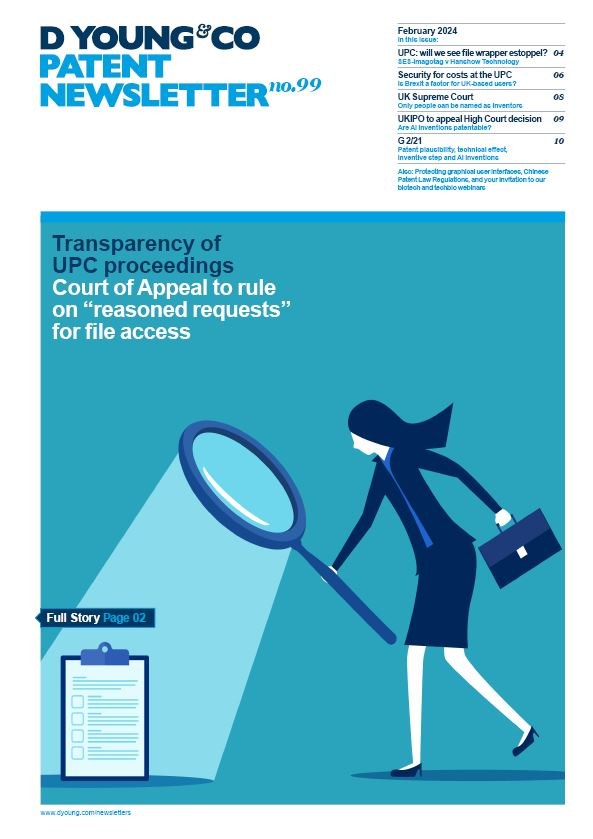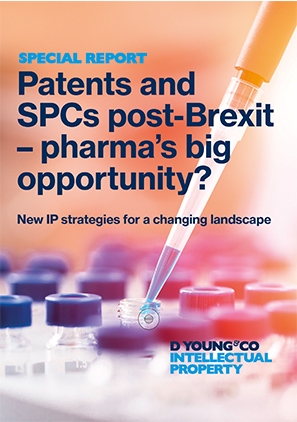AI & IP consultation - focus on patents
In view of the increasing use of artificial intelligence (AI) in fields of research as diverse as drug discovery and automotive design, a consideration of inventorship issues arising from this use is warranted; and the UKIPO is currently undertaking a consultation focusing on potential changes to copyright and patent law. Here we explore the issues considered by the consultation and explain the reasoning behind our response, with a particular focus on patents. In a later newsletter we will explore the issues surrounding copyright and data mining in more detail.
The UK Patents Act (UKPA) defines an inventor as “the actual deviser of the invention” (Section 7(3) UKPA). It is currently accepted within UK law that this must be a person (Thaler v Comptroller General of Patents, Trademarks & Designs, 2020, EWHC 2412(Pat)), and this view has also recently been confirmed by the EPO (J8/20 & J9/20).
As AIs become increasingly autonomous and complex, the patents section of the current consultation focuses on whether AIs could, and should, be listed as inventors, as has recently been accepted in Australia and South Africa. This is of course an important issue in the UK, where patent ownership follows inventorship.
As part of the consultation the UKIPO has identified four potential ways forward:
| Patent inventorship | |
|---|---|
| Option 0 | Make no legal change. |
| Option 1 | “Inventor” expanded to include humans responsible for an AI system which devises inventions. |
| Option 2 | Allow patent applications to identify AI as inventor. |
| Option 3 | Protect AI-devised inventions through a new type of protection. |
Making no legal change is not fit for purpose
In our opinion the UKIPO’s current system for determining inventorship of inventions made using an AI is not fit for purpose since it gives no credit for the invention to the devisor of the AI, even though they may have been instrumental in arriving at the invention. We therefore consider that option 0, make no legal change, should not be adopted.
“Inventors” should be expanded to include humans responsible for an AI system
In our response to the consultation we strongly advocated for option 1, which would see the term “inventor” expanded to include humans responsible for an AI system that generates inventions. This appears to be broadly in line with the approach recently adopted by the German Federal Court.
We consider that, for the foreseeable future, AIs simply cannot be considered to be inventors. AIs are increasingly capable of generating new things which are not obvious to a person skilled in the art, as required for inventive step. However, this does not mean that the AI is the devisor of the invention because there is an implication of planning, forethought and foresight within the term ‘”devise” that cannot be achieved by current AIs.
Typically, the planning, forethought, and foresight required to devise an invention are provided by the people responsible for creating and training an AI. The AI then generates an output or function, which is latent within a concept space occupied by the training set and inputs provided by those people. Hence whilst the output of the AI may be novel and non-obvious, the AI is merely a sophisticated processing tool and therefore cannot be considered an inventor. Rather, in this scenario, the inventors should be the people responsible for training the AI.
Option 1 could be achieved by amending the Patents Act to include a new provision similar to section 9(3) of the Copyright, Designs and Patents Act 1988 (CDPA), where authorship is accorded to the person “by whom the arrangements necessary for the creation of the work are undertaken”. This seems to be a clear and straightforward option, and would unify the approach between copyright, designs and patents.
Identifying AIs as inventors would lead to additional problems
As discussed, we consider that AIs are simply not capable of devising inventions, and therefore cannot be considered inventors.
In addition, identifying AIs as inventors on UK patent applications would lead to a series of additional problems.
For example, declaring AIs to be inventors opens up questions for inventive step, who the skilled person still is and what forms the state of the art. The skilled person is conventionally understood to have full knowledge, but a limited capacity for innovation. Meanwhile the knowledge of an AI is limited to its training and by its architecture, but within that it may have the potential to fully explore the concept space these define.
Different training, architectures, and inputs of AIs can be assumed to generate different inventive capabilities, but are all unknowns that create a new degree of uncertainty when assessing inventive step. This uncertainty would be mirrored in deciding what constitutes the state of the art for an AI. For example, AIs could be considered exempt from knowledge that is offline such as paper-only books, or public prior use. Conversely, AIs could be considered able to use machine-readable data such as binary or encoded information not normally treated as practically accessible to the skilled person.
There are also a number of practical obligations placed upon inventors, including assigning and licencing patent applications. These could not be performed by an AI.
We must also consider the implications that amending UK law to list AIs as inventors would have on applications which are subsequently filed in other jurisdictions. For example, an AI could not fulfil the assignment and declaration requirements of the US. Further, where an AI is in the cloud, it may be difficult to assign a nationality to an AI, which would have implications in countries which require patent applications to be first filed as a national application. Finally, if an AI can be acknowledged as an inventor in the UK, but not in other jurisdictions, there are implications for both the inventorship and ownership of applications claiming priority to a UK application which lists an AI as an inventor. This may lead to the need to first file outside the UK in a jurisdiction which does not allow AIs to be listed as inventors, to ensure a valid priority application which can be relied on in all jurisdictions.
In short, allowing AIs to be listed as inventors has a number of legal and practical implications in both the UK and other jurisdictions which would need to be addressed if this option were pursued.
Protecting innovation produced using AI through a new type of protection is not appropriate
The final option proposed in the UKIPO consultation is a new sui generis right for alleged AI inventions. We consider that there is no need for such a right if we accept that AIs are not capable of devising inventions. Further, the introduction of a new right is also likely to lead to additional issues making it an unattractive proposal.
Although many people discuss AIs as though they were identical this is, of course, incorrect. A new right for alleged AI inventions would require AIs to be accurately defined in order to determine which inventions should be protected by this right. Since not all innovation which involves the use of an AI is likely to be derived solely by the AI, careful consideration would also need to be given to when an AI is used as a tool and when the AI itself has produced the invention. In such a rapidly developing field these are likely to represent ongoing and substantial challenges.
It would represent another challenge to determine the appropriate scope of protection for such a new right. If the scope were the same as that of a traditional patent one would query why the new right is actually required. Similarly, if the new right were to offer more limited protection the new right may be unappealing, as may currently be the case for utility patents in some jurisdictions.
There are also likely to be difficulties associated with claiming priority from the new right in jurisdictions which do not offer a corresponding right for AI inventions. This could represent a significant hurdle, requiring either a large number of bilateral agreements or an amendment to the Paris Convention to recognise the new right.
There are also likely to be difficulties if an invention is considered to have been co-invented by a human and an AI. At present it is not clear whether such an invention should be protected by a patent or by a new sui generis right, and whether it would be possible for an invention to be transferred between the patent system and the new sui generis right if, for example, the claims were limited during prosecution to exclude the contribution made by the human or by the AI. This would lead to new uncertainty for third parties.
Conclusion
It is apparent that AIs will make a comprehensive contribution to innovation over the coming years. There is therefore a need to ensure that such innovation is appropriately protected and attributed in order to encourage innovation. However we consider that AIs are simply not capable of devising inventions, and that they should therefore not be listed as inventors on patent applications. A sui generis right would be unlikely to offer appropriate protection, both in the UK and abroad, particularly in view of the rapidly evolving nature and widespread use of this technology.
We consider that the most appropriate response to the present consultation is an expanded definition of the term “inventor” to include humans responsible for an AI system which generates patentable subject-matter. In this way, such innovations would be appropriately protected and owned whilst maintaining certainty for all parties.



